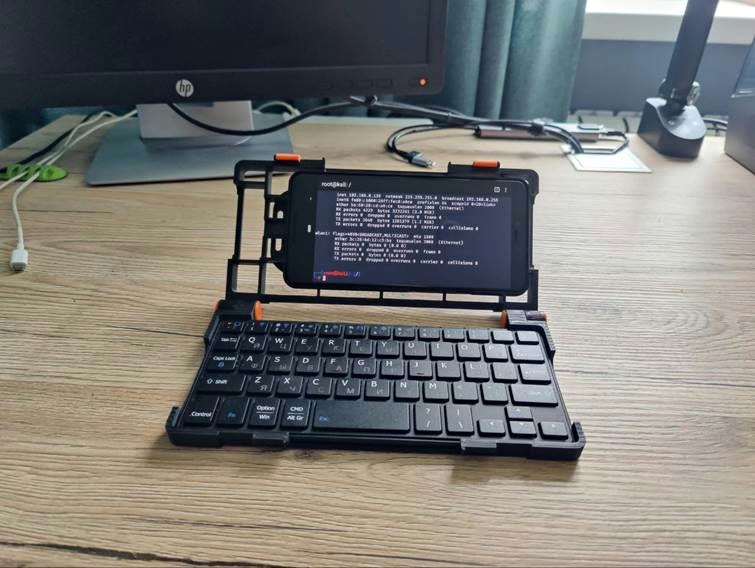
NetHunter C-deck 是一个 DIY 项目,将 Google Pixel 3 XL 手机改造为便携式掌上电脑。通过 3D 打印的 clamshell 案例和蓝牙键盘,搭配 Kali NetHunter 系统,提供渗透测试、网络分析等功能。适用于现场工作、诊断和便携式 Linux 终端需求。 2025-6-6 06:32:9 Author: www.mobile-hacker.com(查看原文) 阅读量:17 收藏
![]()
In an age where laptops are getting slimmer and smartphones more powerful, there’s still a niche for compact, dedicated computing devices that offer the best of both worlds. Say hello to the NetHunter C-deck, a brilliant DIY project by s.gordienko that transforms an older Google Pixel 3 XL into a highly portable, clamshell-style palmtop. You can find the full project details and files on Hackaday. In short, its a 3D-printed, minimalist palmtop-style chassis designed to case a Google Pixel 3 XL smartphone.

This setup serves as a convenient alternative to carrying a full-sized laptop or struggling with a smartphone’s virtual keyboard for complex technical tasks. It offers comfortable typing and an efficient portability. For anyone needing a dedicated terminal for on-the-go computing, diagnostics, or fieldwork, this project gives a capable, older smartphone a valuable second life as a functional and easily deployable palmtop.
If you would like to start to learn hacking with Kali NetHunter with your smartphone, check out our free 16-part blog series on installing, setting up, and using Kali NetHunter for mobile ethical hacking.
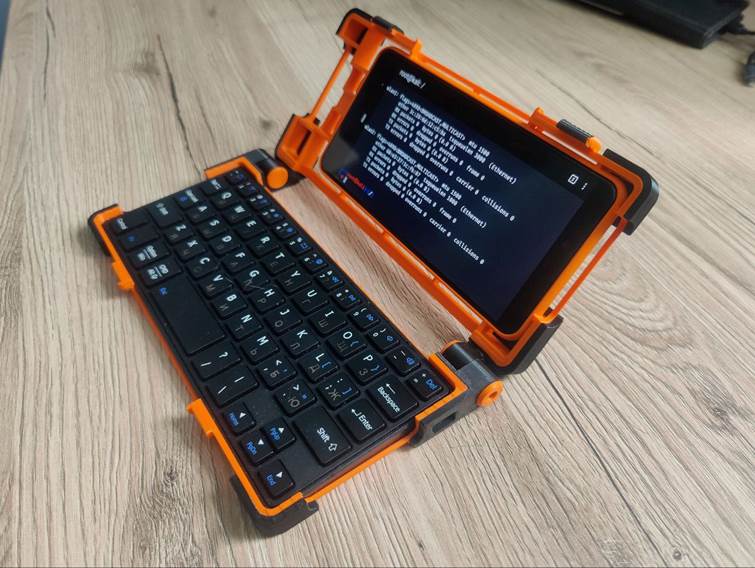
What is the NetHunter C-deck?
The NetHunter C-deck is essentially a DIY portable cyberdeck built around a Google Pixel 3 XL smartphone running Kali NetHunter. The core of the project involves a custom 3D-printed clamshell case that securely holds both the smartphone and a Bluetooth keyboard.
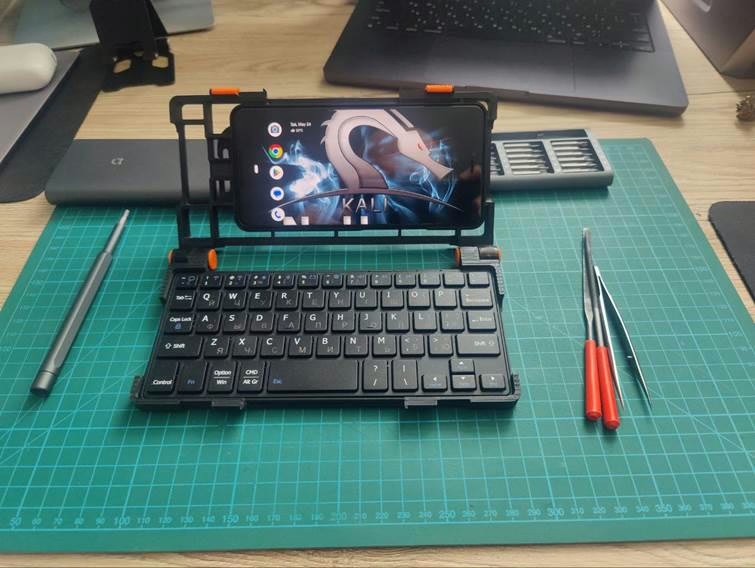
At its heart, this device leverages the power of Kali NetHunter, which is a mobile penetration testing platform built on Kali Linux. This makes it an ideal, low-cost platform for penetration testing, network analysis or actually any Linux-can-make-it-done on-the-go work. Whether you’re configuring network equipment on-site, troubleshooting issues, or performing security audits, having a full-fledged Linux environment in your pocket offers flexibility.
Build Your Own Cyberdeck
The beauty of the NetHunter C-deck lies in its DIY nature, making it accessible for anyone with a 3D printer and a few readily available components. To build your own, you’ll need the following key components:
- Google Pixel 3 XL: The smartphone that serves as the computing core.
- Universal Bluetooth Keyboard: For comfortable typing and interaction.
- USB-C OTG with Charging: To connect peripherals while charging.
- Hook and Loop Cable Ties (3x): For cable management (though the latest design has simplified this).
- M3x12 screws (2x): For assembly.
While the project specifically provides 3D model files for the Google Pixel 3 XL, the concept of turning a smartphone into a cyberdeck is adaptable. Other smartphones capable of running Kali NetHunter, like the OnePlus 7 Pro or 7T, could potentially be used. However, if you choose a different smartphone, you will need to customize or redesign the 3D print files to fit your specific device.
Evolution of the Clamshell Design
The NetHunter C-deck case has undergone several iterations, each aimed at improving ease of printing and assembly while maintaining its attractive appearance.
- Version 1.0.0 was designed with ruggedness in mind and offered attractive multi-color printing options. You can download 3D models here Pixel 3 XL NetHunter Clamshell Palmtop v1.0.zip

- Version 2.0.0 prioritized a less complex assembly with fewer 3D-printed parts, making it much easier to put together. You can download 3D models here Pixel 3 XL NetHunter Clamshell Palmtop v2.0.1.zip.
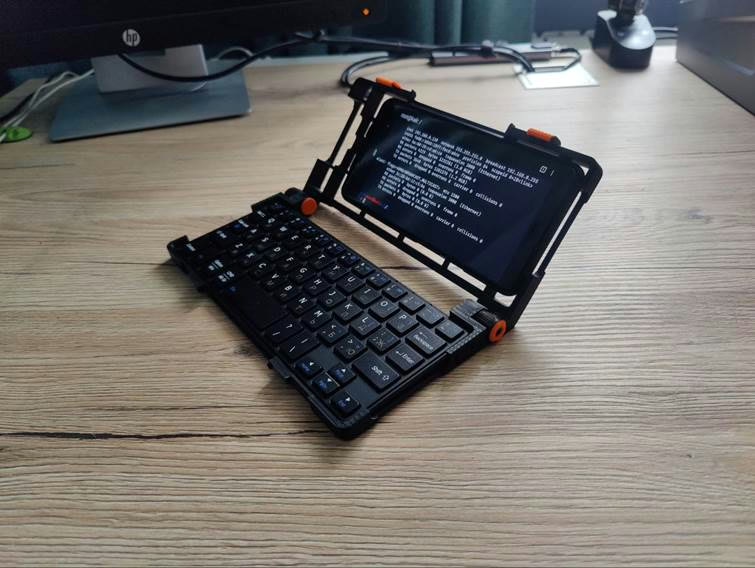
- The latest and likely final version, 2.1.0, further refines the design by moving the phone to the center of the lid and removing unnecessary parts for securing cables or external cards with plastic ties, making the overall structure cleaner and more efficient. You can download 3D models here Pixel 3 XL NetHunter Clamshell Palmtop v2.1.0.zip.
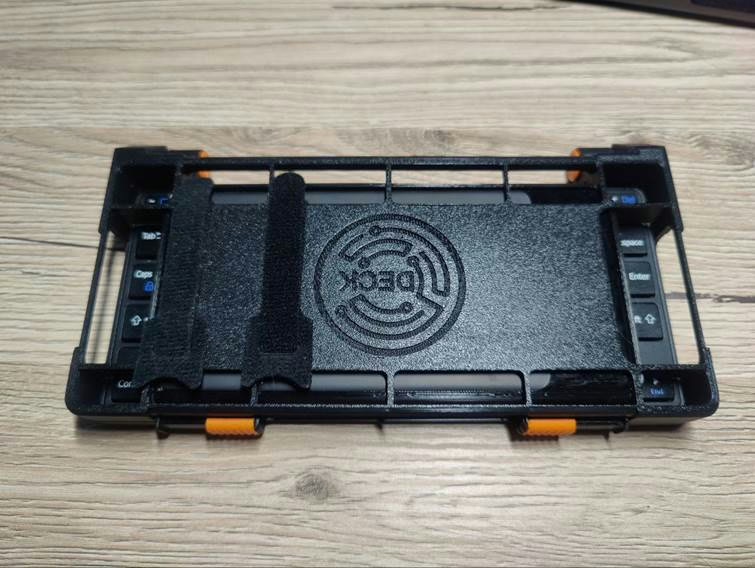
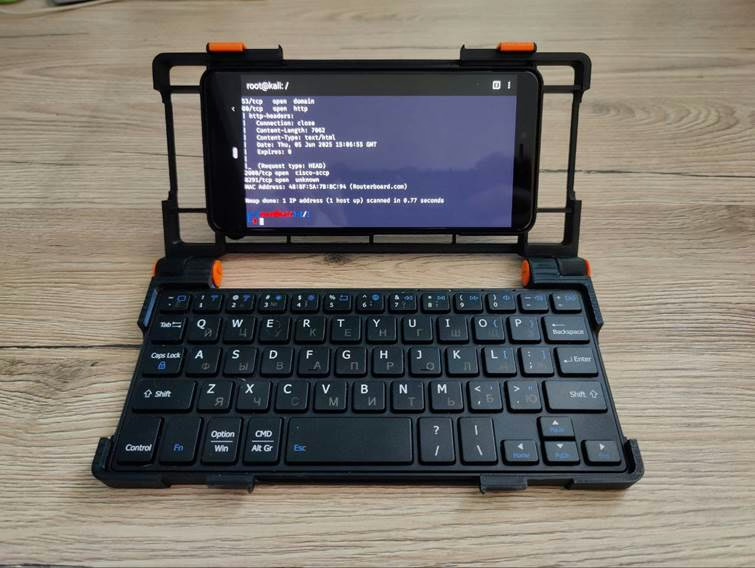
A significant feature across these designs is the panel on the back of the lid, which is specifically designed to mount external adapters for Wi-Fi, Bluetooth, SDR (Software Defined Radio) connected via an OTG cable.
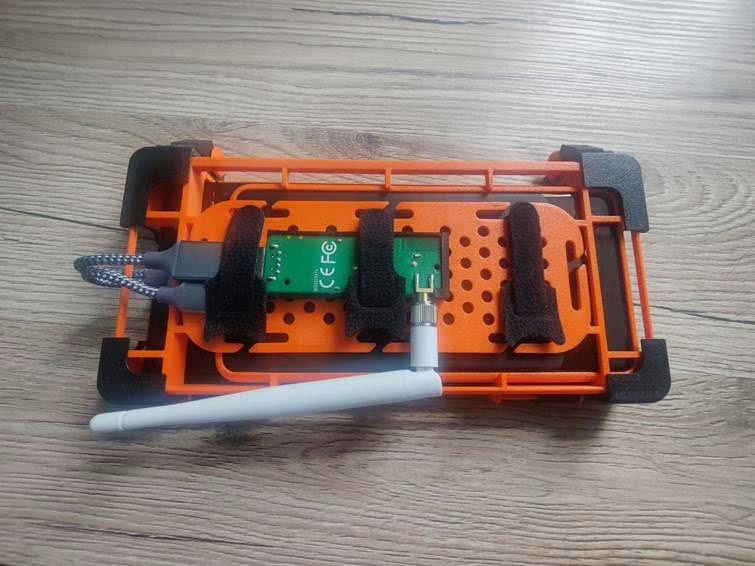
How to Install Kali NetHunter on Pixel 3 XL
For those eager to dive into the software aspect, s.gordienko has provided detailed instructions on installing Kali NetHunter on the Google Pixel 3 XL. Original installation steps you can find on XDA Developer. Installation included flashing custom Kernel with support for internal Wi-Fi monitor mode (packet injection not supported), BadUSB, popular external Wi-Fi adapters etc. Here’s a summary of the steps:
Prerequisites:
- Flash Stock Android 12: Install the latest Android 12 image for Pixel 3 XL (specifically the ‘crosshatch’ variant) from the official Google Developers site.
- Enable Developer Mode & USB Debugging: Go to Settings > About phone, tap Build number 7 times. Then navigate to Settings > System > Developer options and enable OEM unlocking and USB debugging.
- Unlock the Bootloader: In Settings > System > Developer options, enable OEM unlocking and confirm the prompt.
Download Required Files:
You’ll need to download several files to your PC:
- TWRP boot image and installer: From
twrp.me/google/googlepixel3xl.html. - Magisk: For root access, from the Magisk GitHub page (remember to change the file extension from
.apkto.zip). - Alynx NetHunter Kernel & Wireless Firmware: Typically found on an XDA Thread.
- Kali NetHunter Full Archive: Download the full NetHunter zip for Pixel 3 XL (crosshatch) from kali.download (e.g.,
kali-nethunter-2025.1c-crosshatch-thirteen-full.zip).
Installation Steps:
- Reboot into Bootloader: Use the ADB command:
adb reboot bootloader. - Boot TWRP Recovery: Use Fastboot:
fastboot boot twrp-3.7.0_12-0-crosshatch.img. - Push Installation Files to the Device: Use ADB to transfer all downloaded zip files to your device’s
/sdcarddirectory. - Install Files via TWRP: In TWRP recovery, go to Install and flash the following zip files in this specific order:
twrp-installer-3.7.0_12-0-crosshatch.zipmagisk28.1.zipAlynx-12-nethunter-bluecross.zipWireless_firmware.zip.
- Reboot to System: Once installation is complete, go back to TWRP > Reboot > System.
- Set Up Magisk: Open the Magisk app, follow the on-screen instructions, and reboot if prompted.
- Install Kali NetHunter Module: Copy the full NetHunter archive to your device. Open the Magisk app > Modules, tap Install from Storage, select the NetHunter zip, and reboot after installation.
Beyond Pentesting: Versatility and Portability
While the NetHunter C-deck is an obvious asset for hackers and penetration testers, rather than for developers, its utility extends far beyond that. This compact, low-cost portable device is ideal for field work, diagnostics, and general-purpose computing. Its ease of portability and quick deployment make it a valuable tool for system administrators, IT professionals, or anyone who needs a portable Linux terminal on the go with physical keyboard. The ability to comfortably type on a physical keyboard and connect external modules turns a simple smartphone into a powerful, pocket-sized cyberdeck.
如有侵权请联系:admin#unsafe.sh